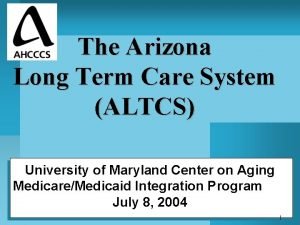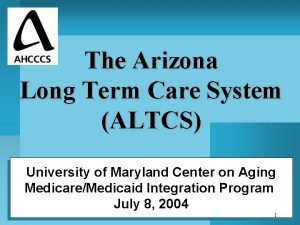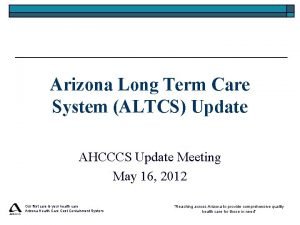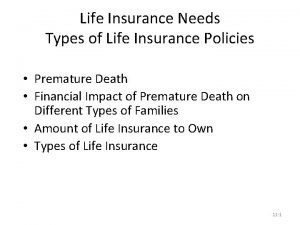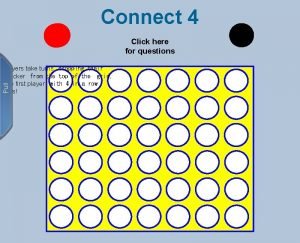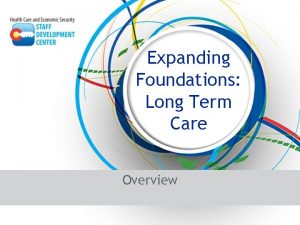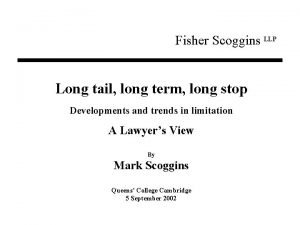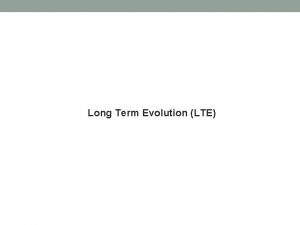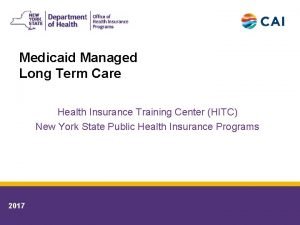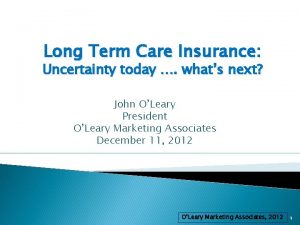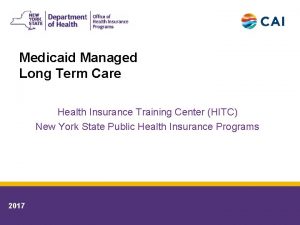The Long Term Care Insurance Kaigo Hoken and
![The Long Term Care Insurance [Kaigo Hoken] and its Impact on Society and Health The Long Term Care Insurance [Kaigo Hoken] and its Impact on Society and Health](https://slidetodoc.com/presentation_image_h2/9975811a701b84ab01022b8970d80f0e/image-1.jpg)




![Financial Redistribution Mechanism by the Elderly Health Care System [EHCS] since 1983 Financial Redistribution Mechanism by the Elderly Health Care System [EHCS] since 1983](https://slidetodoc.com/presentation_image_h2/9975811a701b84ab01022b8970d80f0e/image-6.jpg)





















![Service Utilization [1] Home vs. Institutional Care Service Utilization [1] Home vs. Institutional Care](https://slidetodoc.com/presentation_image_h2/9975811a701b84ab01022b8970d80f0e/image-28.jpg)
![Service Utilization [2] Institutional Care Service Utilization [2] Institutional Care](https://slidetodoc.com/presentation_image_h2/9975811a701b84ab01022b8970d80f0e/image-29.jpg)
![Service Utilization[3] Home care Service Utilization[3] Home care](https://slidetodoc.com/presentation_image_h2/9975811a701b84ab01022b8970d80f0e/image-30.jpg)






- Slides: 36
![The Long Term Care Insurance Kaigo Hoken and its Impact on Society and Health The Long Term Care Insurance [Kaigo Hoken] and its Impact on Society and Health](https://slidetodoc.com/presentation_image_h2/9975811a701b84ab01022b8970d80f0e/image-1.jpg)
The Long Term Care Insurance [Kaigo Hoken] and its Impact on Society and Health Care System in Japan Ato. Z OKAMOTO, MD, MPH National Institute of Public Health

l. Background l. Development l. Implementation l. Outcome l. Conclusions

Why was the LTCI developed? l Rapidly aging population and growing need for LTC – Elderly population >65 will be 25% of the population l Structural overhaul of the fragmented health insurance system l Effective integration of medical and non-medical services

Structural flaws of Japan’s health insurance system

Age distribution and health insurance status
![Financial Redistribution Mechanism by the Elderly Health Care System EHCS since 1983 Financial Redistribution Mechanism by the Elderly Health Care System [EHCS] since 1983](https://slidetodoc.com/presentation_image_h2/9975811a701b84ab01022b8970d80f0e/image-6.jpg)
Financial Redistribution Mechanism by the Elderly Health Care System [EHCS] since 1983

Medical vs. Non-medical Services before the LTCI l Medical---health insurance and EHCS financed by premium – Not restricted by budget -> cost inflation – Dictated by doctors’ prescription->not need-based l Non-medical---welfare system financed by tax – Restricted by budget -> frugal use of services – Restricted by income -> social stigma l Result: unusual shift of LTC toward medical services – Prolonged hospital length of stay (40 days)

l. Background l. Development l. Implementation l. Outcome l. Conclusions

Tax vs. Premium l. Agreement: Create a new system rather than expanding the old one. l. Economists: Why not social insurance? l. Prime Minister Hosokawa (1994): National Welfare Tax – Ended up in fiasco and he resigned

Campaign for the LTCI l. German LTCI started in 1995 l. Opinion Poll-> 86% support the LTCI l. Conversion of the Nordic faction

Technical Development(1) -Need Assessment Tool l. Evidence-based development (one-minute time study) l. Methodologically similar to the U. S. MDS and RUG

Technical Development (2) -Care Management l. British Community Care Act 1990 l. Coordination between medical and non-medical services

l. Background l. Development l. Implementation l. Outcome l. Conclusions

Administrative Structure l Administered by municipal governments (cities, townships and villages depending on population size) l Advantage over fragmented health insurance system – Larger risk pool and more stale actuarial operation – Enabling municipal governments to develop regional, long range plans

l. Covers Beneficiaries half of the population ( as opposed to health insurance) l. Beneficiaries category I: aged 65 or older (17% of population) l. Beneficiaries category II: aged 40 -64 (33% of population) l. Originally planned to cover 20 years or older

Beneficiaries and Financing

Need Assessment l Application (a sharp contrast to health insurance) l On-site survey by qualified care managers using a uniform assessment tool (73 items) l Attending doctor’s professional opinion l Preliminary assessment by computer (dismiss, borderline, level 1 -5) l The need assessment review committee makes final judgment

How the need assessment review committee altered the preliminary assessment

Benefit l Institutional care – Geriatric hospitals (medical) – Skilled Nursing Facilities (medical) – Nursing homes (non-medical) l Home care – visiting nursing, day care (medical) – home help, day service (non-medical)

Integration of Medical and Non-medical Services under the LTCI

Benefit in monetary terms according to the level of care need (unit 10 -10. 72 yen, subject to 10% copayment) Monthly “cap” for home care Per diem cost for SNF Borderline 6150 Not permitted Level 1 16580 880 Level 2 19480 930 Level 3 26750 980 Level 4 30600 1030 Level 5 35830 1080

Double Talk in Home Care l The LTCI law : same kind of home care services shall be “bundled” under the same budgetary limit (=monthly cap) l The Medical laws: medical services shall not be rendered by non-qualified personnel. They also shall be prescribed by doctors.

Controversy over cash benefit l. Whether cash benefit should awarded to family care givers who do not use external services – No!—women citizen group – Yes—economists, medical association l. Decision---NO

l. Background l. Development l. Implementation l. Outcome l. Conclusions

Boom and Bust l. Government’s worry about shortage of services l. Deregulation to encourage for-profit corporations into home care “industry” l. Kaigohoken Boom l. Less than expected demand -> Bubble Burst

Saga of Nichii Gakkan (TSE quotes)

Service Utilization in the first year l. Total reimbursement: 3. 2 trillion yen (84% of expected) l. Home care vs Institutional care = 1: 2 l. Gradual but steady increase of services
![Service Utilization 1 Home vs Institutional Care Service Utilization [1] Home vs. Institutional Care](https://slidetodoc.com/presentation_image_h2/9975811a701b84ab01022b8970d80f0e/image-28.jpg)
Service Utilization [1] Home vs. Institutional Care
![Service Utilization 2 Institutional Care Service Utilization [2] Institutional Care](https://slidetodoc.com/presentation_image_h2/9975811a701b84ab01022b8970d80f0e/image-29.jpg)
Service Utilization [2] Institutional Care
![Service Utilization3 Home care Service Utilization[3] Home care](https://slidetodoc.com/presentation_image_h2/9975811a701b84ab01022b8970d80f0e/image-30.jpg)
Service Utilization[3] Home care

Growth of Elderly eligible for benefit

Plight of Visiting Nurses

Price Competition between Home Help and Visiting Nursing (price for 30 min to 1 hr, unit 10 -10. 72 yen, subject to 10% copayment) l Home Help – Chiefly domestic services->153 – Mixed->278 – Chiefly personal care->402 l Visiting Nursing – Hospital or clinics->550 – Independent Visiting Nursing Stations [IVNS]->830

Care Managers: to whom they report? l. Care Managers are expected to act as an “agent” of clients l. Reality: majority of them are “sales representatives” of service providers l. Need to establish them as independent professionals

l. Background l. Development l. Implementation l. Outcome l. Conclusions

What have we learned? l Increased awareness of people about welfare and social services l Prompted a national debate over the goal to which we achieve l A great social experiment to create and implement a new system l A model for Asian countries to cope with aging population?
 Short medium and long term planning in education
Short medium and long term planning in education Short term human resources
Short term human resources Difference between long term and short term liabilities
Difference between long term and short term liabilities Accounting for serial bonds
Accounting for serial bonds Ling term goals
Ling term goals Short-term financial management
Short-term financial management Long term memory vs short term memory
Long term memory vs short term memory Tall+short h
Tall+short h Once upon a time lived
Once upon a time lived Từ ngữ thể hiện lòng nhân hậu
Từ ngữ thể hiện lòng nhân hậu Institutional medicaid
Institutional medicaid Altcs arizona long term care
Altcs arizona long term care Arizona long term care system (altcs)
Arizona long term care system (altcs) Ahcccs long term care
Ahcccs long term care Ltc map ct
Ltc map ct Tertiary level of care
Tertiary level of care Features of fire insurance
Features of fire insurance Insurance
Insurance Long term storage and retrieval
Long term storage and retrieval Anorexia nervosa consequences long term
Anorexia nervosa consequences long term Long term storage and retrieval
Long term storage and retrieval Long term objectives and strategies
Long term objectives and strategies Long-term debt preferred stock and common stock
Long-term debt preferred stock and common stock Long term financial planning and growth chapter 4
Long term financial planning and growth chapter 4 Sustainable growth equation
Sustainable growth equation What is long term loans and advances
What is long term loans and advances To establish effective short- and long-term goals ____.
To establish effective short- and long-term goals ____. Long term financial planning and growth
Long term financial planning and growth First care health plan
First care health plan Tinikling props
Tinikling props Greek
Greek In my understanding
In my understanding Term-to-term rule
Term-to-term rule Position-to-term rule
Position-to-term rule Minterm maxterm
Minterm maxterm Nth term rule
Nth term rule Term to term rule
Term to term rule











